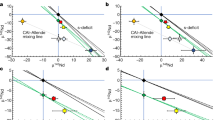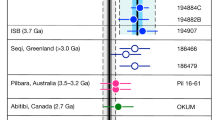Abstract
The 142Nd/144Nd ratio of the Earth is greater than the solar ratio as inferred from chondritic meteorites, which challenges a fundamental assumption of modern geochemistry—that the composition of the silicate Earth is ‘chondritic’, meaning that it has refractory element ratios identical to those found in chondrites. The popular explanation for this and other paradoxes of mantle geochemistry, a hidden layer deep in the mantle enriched in incompatible elements, is inconsistent with the heat flux carried by mantle plumes. Either the matter from which the Earth formed was not chondritic, or the Earth has lost matter by collisional erosion in the later stages of planet formation.
This is a preview of subscription content, access via your institution
Access options
Subscribe to this journal
Receive 51 print issues and online access
$199.00 per year
only $3.90 per issue
Buy this article
- Purchase on Springer Link
- Instant access to full article PDF
Prices may be subject to local taxes which are calculated during checkout



Similar content being viewed by others
References
Lodders, K., Palme, H. & Gail, H.-P. in Landolt-Börnstein New Series (ed. Trumper, J. E.) Vol. VI/4B, Ch. 4.4 560–630 (Springer, 2009)
Meibom, A. & Clark, B. E. Evidence for the insignificance of ordinary chondritic material in the asteroid belt. Meteorit. Planet. Sci. 34, 7–24 (1999)
Pourmand, A., Dauphas, N. & Ireland, T. J. A novel extraction chromatography and MC-ICP-MS technique for rapid analysis of REE, Sc and Y: revising CI-chondrite and Post-Archean Australian Shale (PAAS) abundances. Chem. Geol. http://dx.doi.org/10.1016/j.chemgeo.2011.08.011 (in the press)
Trinquier, A. et al. Origin of nucleosynthetic isotope heterogeneity in the solar protoplanetary disk. Science 324, 374–376 (2009)
Regelous, M., Elliott, T. & Coath, C. D. Nickel isotope heterogeneity in the early Solar System. Earth Planet. Sci. Lett. 272, 330–338 (2008)
Andreasen, R. & Sharma, M. Mixing and homogenization in the early solar system: clues for Sr, Ba, Nd, and Sr isotopes in meteorites. Astrophys. J. 665, 874–883 (2007)
Carlson, R. W., Boyet, M. & Horan, M. Chondritic barium, neodymium, and samarium isotopic hetrogeneity and early Earth differentiation. Science 316, 1175–1178 (2007)
Burkhardt, C. et al. Molybdenum isotope anomalies in meteorites: constraints on solar nebula and origin of the Earth. Earth Planet. Sci. Lett. 312, 390–400 (2011)
Bouvier, A., Vervoort, J. D. & Patchett, P. J. The Lu–Hf and Sm–Nd isotopic composition of CHUR: constraints from unequilibrated chondrites and implications for the bulk composition of terrestrial planets. Earth Planet. Sci. Lett. 273, 48–57 (2008)
Drake, M. J. & Righter, K. Determining the composition of the Earth. Nature 416, 39–44 (2002)
Lodders, K. Solar system abundances and condensation temperatures of the elements. Astrophys. J. 591, 1220–1247 (2003)
Safronov, V. S. Evolution of the Protoplanetary Cloud and Formation of the Earth and the Planets (Israel Program for Scientific Translations, 1972)
O’Neill, H. & St C &. Palme, H. Collisional erosion and the non-chondritic composition of the terrestrial planets. Phil. Trans. R. Soc. A 366, 4205–4238 (2008)This paper discusses how the compositions of terrestrial planets may change during the later stages of their accretion.
Halliday, A. N. & Porcelli, D. In search of lost planets—the paleocosmochemistry of the inner solar system. Earth Planet. Sci. Lett. 192, 545–559 (2001)
Boyet, M. & Carlson, R. W. 142Nd evidence for early (>4.53 Ga) global differentiation of the silicate Earth. Science 309, 576–581 (2005)Here the 142Nd/144Nd for chondritic meteorites is shown to be 20 parts per million less than that of most terrestrial rocks.
Boyet, M. & Carlson, R. W. A new geochemical model for the Earth’s mantle inferred from 146Sm–142Nd systematics. Earth Planet. Sci. Lett. 250, 254–268 (2006)This paper discusses the implications of excess 142Nd/144Nd in terrestrial samples in terms of a non-chondritic mantle and a hidden reservoir.
Kinoshita, N. et al. Geocosmochronometer 146Sm: a revised half-life value. Mineral. Mag. (Goldschmidt Conf. Abstr.) 75, 1191 (2011)
Qin, L.-P., Carlson, R. W., Alexander, C. M. & O’D Correlated nucleosynthetic isotopic variability in Cr, Sr, Ba, Sm, Nd and Hf in Murchison and QUE 97008. Geochim. Cosmochim. Acta 75, 7806–7828 (2011)
Patchett, P. J., Vervoort, J. D., Söderlund, U. & Salters, V. J. M. Lu–Hf and Sm–Nd isotopic systematics in chondrites and their constraints on the Lu–Hf properties of the Earth. Earth Planet. Sci. Lett. 222, 29–41 (2004)
Andreasen, R. Sharma, M. Subbarao, K. V. & Viladkar, S. G. Where on Earth is the enriched Hadean reservoir? Earth Planet. Sci. Lett. 266, 14–28 10.1016/j.epsl.2007.10.009. (2008)
Caro, G., Bourdon, B., Birck, J.-L. & Moorbath, S. High-precision 142Nd/144Nd measurements in terrestrial rocks: constraints on the early differentiation of the Earth’s mantle. Geochim. Cosmochim. Acta 70, 164–191 (2006)
Labrosse, S., Herlund, J. W. & Coltice, N. A crystallizing dense magma ocean at the base of the Earth’s mantle. Nature 450, 866–869 (2007)
Davies, G. F. Mantle plume, mantle convection and hotspot chemistry. Earth Planet. Sci. Lett. 99, 94–109 (1990)
Loper, D. & Lay, T. The core-mantle boundary region. J. Geophys. Res. 100, 6397–6420 (1995)
Korenaga, J. A method to estimate the composition of the bulk silicate Earth in the presence of a hidden geochemical reservoir. Geochim. Cosmochim. Acta 73, 6952–6964 (2009)
Bourdon, B., Touboul, M., Caro, G. & Kleine, T. Early differentiation of the Earth and the Moon. Phil. Trans. R. Soc. A 366, 4105–4128 (2008)
Nyquist, L. E. et al. 146Sm–142Nd formation interval for the lunar mantle. Geochim. Cosmochim. Acta 59 (13). 2817–2837 (1995)
Boyet, M. & Carlson, R. W. A highly depleted moon or a nonmagma ocean origin for the lunar crust? Earth Planet. Sci. Lett. 262, 505–516 (2007)
Brandon, A. D. et al. Re-evaluating 142Nd/144Nd in lunar mare basalts with implications for the early evolution and bulk Sm/Nd of the Moon. Geochim. Cosmochim. Acta 73, 6421–6445 (2009)
Caro, G. & Bourdon, B. Non-chondritic Sm/Nd ratio in the terrestrial planets: consequences for the geochemical evolution of the mantle-crust system. Geochim. Cosmochim. Acta 74, 3333–3349 (2010)
Tonks, W. B. & Melosh, H. J. Magma ocean formation due to giant impacts. J. Geophys. Res. 98, 5319–5333 (1993)
Campbell, I. H. The identification of old mantle plumes. Geol. Soc. Am. Spec. Publ. 352, 5–21 (2001)
Tolstikhin, I. N., Kramers, J. D. & Hofmann, A. W. A chemical Earth model with whole mantle convection: the importance of a core-mantle boundary layer (D′′) and its early formation. Chem. Geol. 226, 79–99 (2006)
Labrosse, S., Hernlund, J. W. & Coltice, N. A crystallizing dense magma ocean at the base of the Earth’s mantle. Nature 450, 866–869 (2007)
Campbell, I. H. & Griffiths, R. W. The changing nature of mantle hotspots through time: implications for the geochemical evolution of the mantle. J. Geol. 100, 497–523 (1992)This paper uses the melting products of mantle plumes in conjunction with knowledge of their dynamics to determine the chemical structure of the mantle and shows how it has evolved with time.
Davies, G. F. Ocean bathymetry and mantle convection. 1. Large-scale flow and hotspots. J. Geophys. Res. 93, 10467–10480 (1988)
Sleep, N. H. Hotspots and mantle plume: some phenomenology. J. Geophys. Res. 95, 6715–6736 (1990)
Davies, G. R. Mantle regulation of core cooling: a geodynamo without core radioactivity. Phys. Earth Planet. Inter. 160, 215–229 (2007)
Davies, J. H. & Davies, D. R. Earth’s surface heat flux. Solid Earth. 1, 5–24 (2010)
Zhong, S. Constraints on thermochemical convection of the mantle from plume heat flux, plume excess temperature, and upper mantle temperature. J. Geophys. Res. 111, B04409 (2006)
Lay, T., Hernlund, J. & Buffett, B. A. Core-mantle boundary heat flow. Nat. Geosci. 1, 25–32 (2008)
Anderson, O. L. The power balance at the core-mantle boundary. Phys. Earth Planet. Inter. 131, 1–17 (2002)
Jackson, M. G. & Carlson, R. W. An ancient recipe for flood-basalt genesis. Nature (2011)This paper demonstrates the existence of an old and primitive component in mantle plumes.
Zindler, A. & Hart, S. R. Chemical geodynamics. Annu. Rev. Earth Planet. Sci. 14, 493–571 (1986)
Hart, S. R., Hauri, H. E., Oschmann, L. A. & Whitehead, J. A. Mantle plumes and entrainment: isotopic evidence. Science 256, 517–520 (1992)
Torsvik, T. H., Burke, K., Steinberger, B., Webb, S. J. & Ashwal, L. D. Diamonds sampled by plumes from the core–mantle boundary. Nature 466, 352–355 (2010)
Lesher, C. M. & Arndt, N. T. REE and Nd isotope geochemistry, petrogenesis and volcanic evolution of contaminated komatiites at Kambalda, Western Australia. Lithos 34, 127–157 (1995)
Hollings, P., Wyman, D. & Kerrich, R. Komatiite-basalt-rhyolite volcanic associations in Northern Superior Province greenstone belts: significance of plume-arc interaction in the generation of the proto continental Superior Province. Lithos 46, 137–161 (1999)
Hollings, P. & Kerrich, R. Trace element systematics of ultramafic and mafic volcanic rocks from 3 Ga North Caribou greenstone belt, northwest Superior Province. Precambr. Res. 93, 257–279 (1999)
Kerrich, R., Polat, A., Wyman, D. & Hollings, P. Trace element systematics of Mg- to Fe-tholeiitic basalt suites of the Superior Province: implications for Archaean mantle reservoirs and greenstone belt genesis. Lithos 46, 163–187 (1999)
Campbell, I. H. in The Earth’s Mantle: Composition, Structure and Evolution 259–310 (Cambridge University Press, 1998)
Campbell, I. H. & Griffiths, R. W. Implications of mantle plume structure for the evolution of flood basalts. Earth Planet. Sci. Lett. 99, 79–93 (1990)
Richards, M. A., Duncan, R. A. & Courtillot, V. E. Flood basalts and hot-spot tracks—plume heads and tails. Science 246, 103–107 (1989)
Griffiths, R. W. & Campbell, I. H. Stirring and structure in mantle starting plumes. Earth Planet. Sci. Lett. 99, 66–78 (1990)
Galer, S. J. G. & Goldstein, S. J. in Earth Processes: Reading the Isotopic Code (eds Basu, A. & Hart, S. ) 75–98 (Geophysical Monograph 95, American Geophysical Union, 1996)
Kleine, T. et al. Hf-W chronology of the accretion and early evolution of asteroids and terrestrial planets. Geochim. Cosmochim. Acta 73, 5150–5188 (2009)
Palme, H., O’Neill, H., St. C & Benz, W. Evidence for collisional erosion of the Earth. Geochim. Cosmochim. Acta 67, A372 (2003)
Caro, G., Bourdon, B., Halliday, A. N. & Quitté, G. Super-chondritic Sm/Nd ratios in Mars, the Earth and the Moon. Nature 452, 336–339 (2008)
White, W. M. & Morgan, J. P. Implication of a non-chondritic Earth for terrestrial heat production and geodynamics. Mineral. Mag. (Goldschmidt Conf. Abstr.) 75, 1191 (2011)
The KamLAND Collaboration. Partial radiogenic heat model for Earth revealed by geoneutrino measurements. Nature Geosci. 4, 647–651 (2011)
Caro, G. Early silicate Earth differentiation. Annu. Rev. Earth Planet. Sci. 39, 31–58 (2011)This is a comprehensive review of Nd isotopes.
Armstrong, R. L. The persistent myth of crustal growth. Aust. J. Earth Sci. 38, 613–630 (1991)
Allègre, C. J., Staudacher, T., Sarda, P. & Kurz, M. Constraints on the evolution of Earth’s mantle from rare-gas systematics. Nature 303, 762–766 (1983)
Barth, M. G., McDonough, W. F. & Rudnick, R. L. Tracking the budget of Nb and Ta in the continental crust. Chem. Geol. 165, 197–213 (2000)
O’Nions, R. K. & Oxburgh, E. R. Heat and helium in the Earth. Nature 306, 429–431 (1983)
Wasson, J. T. & Kallemyn, G. W. Composition of chondrites. Phil. Trans. R. Soc. A325, 535–544 (1988)
Workman, R. K. & Hart, S. R. Major and trace element composition of the depleted MORB mantle (DMM). Earth Planet. Sci. Lett. 231, 53–72 (2005)
Acknowledgements
We thank Y. Amelin and R. Taylor for their comments on an early draft of the paper, C. Allen for preparing Fig. 1 and R. Carlson and B. Bourdon for their detailed and constructive reviews.
Author information
Authors and Affiliations
Contributions
Both authors contributed equally to the manuscript.
Corresponding author
Ethics declarations
Competing interests
The authors declare no competing financial interests.
Rights and permissions
About this article
Cite this article
Campbell, I., St C. O’Neill, H. Evidence against a chondritic Earth. Nature 483, 553–558 (2012). https://doi.org/10.1038/nature10901
Published:
Issue Date:
DOI: https://doi.org/10.1038/nature10901
Comments
By submitting a comment you agree to abide by our Terms and Community Guidelines. If you find something abusive or that does not comply with our terms or guidelines please flag it as inappropriate.



